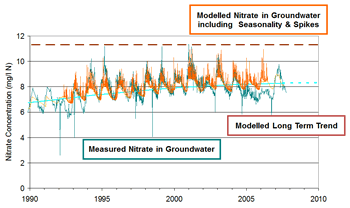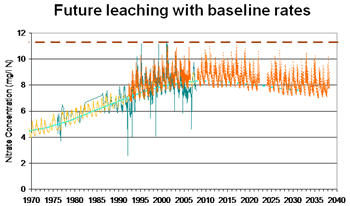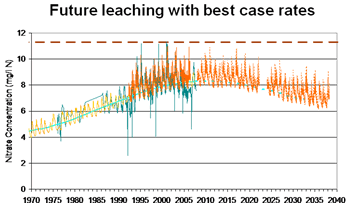Nitrates
Long Term Nitrate Trend Modelling
A study by BGS (direct link) published in 2007 established that 41% of some 191 distinct borehole supplies had rising nitrate trends that could exceed the drinking water standard of 50 mg/l by 2015. Statistical approaches on nitrate datasets have also been used by the Environment Agency to help identify which groundwater bodies are at risk and which areas should be or remain designated as nitrate vulnerable zones. Water Companies have also used similar approaches to predict whether nitrate treatment or blending would be required in the AMP5 period or beyond to help financial planning discussions with OFWAT. However, the problem with relying on past trends to predict future trends is, just as for stocks and shares, past trends don’t always continue.
Wessex Water Services Ltd commissioned Entec UK Ltd to develop a new approach which would help better estimate future nitrate trends; looking at long term trends, but also factors such as seasonality and spikiness. Nick directed this Entec UK Ltd project (See Reference #7 on Downloads page) and technically developed a new mechanistic rather than statistical approach which made good use of existing GIS data collated for water resource / recharge models and combined this with an Excel Spreadsheet model. Good model fits were achieved on a number of public water supply trends and this gave greater confidence in predicting how long it would take for any catchment management efforts to affect nitrate concentrations in these supplies.
Comparing Modelled and Measured Nitrate Concentrations
This figure shows a comparison of measured nitrate concentrations at a Chalk borehole public water supply to modelled concentrations.
The modelled long term trend takes into account the delay in travel through the unsaturated zone of historically leached nitrate. The seasonality and spikiness part of the modelled concentrations are empirically rather than mechanistically related to groundwater level fluctuations and bypass recharge events respectively.
Examining the Effect of Voluntary Changes in Farming Practice
The work by ADAS (http://www.adas.co.uk/) on the WAgriCo project established that use of a number of voluntary measures by farmers could as a ‘best case’ reduce nitrate leaching by up to 15% on arable land and 5% on managed grassland compared to a ‘baseline’.
This figure shows future predictions of modelled nitrate concentrations at a public water supply borehole assuming these baseline and best case nitrate leaching rates.
The delayed response of ten to twenty years is related to the travel through the unsaturated zone.
The results of this work were presented at national conferences in 2007 (See Reference #6 on Downloads page) and 2008 (See Reference #7 on Downloads page) and led to Entec UK Ltd’s / Nick's involvement in the EU Life / DEFRA funded UKWIR managed project called WAgriCo. The work was undertaken in cooperation with ADAS, Wessex Water and the Environment Agency. Nick presented on the WAgriCo project work in September 2008 in Lower Saxony, Germany and in London in (See Reference #8 on Downloads page) and the work is reported (UKWIR report 08/WR/26/7) formally as a supporting document to the main WAgriCo reports.
The above links to published presentations and reports will give you more information on Nick’s work, presentation style and report writing.
Also in 2007-8, Nick undertook nitrates related work with Severn Trent Water and Cambridge Water, principally related to understanding long term trend and assessing the feasibility of changing long term trends through catchment management.
Nick has continued working on long term nitrate trends as an advisor to Entec UK Ltd then AMEC E&I UK Ltd on a project for the Wessex Region of the Environment Agency. Phase 1 of this work was carried out between January and April 2010 and Phase 2 was undertaken autumn-winter 2010. Nick has also supported Wessex Water directly since 2010; providing estimates of future nitrate concentrations in groundwater supplies, which will form part of a blended network, and supporting them in proposals to use catchment management to offset increased nitrogen inputs to Poole Harbour related to new housing development and associated increases in sewage.
Short Term Nitrate Variations
One of Nick’s recent areas of work / research has been to try and understand the factors that lead to seasonal variations and short term spikes in nitrate concentrations, particularly in Chalk sources. Understanding of the controlling processes has important implications for both recharge / water resources modelling and assessing the impact of current land management on current groundwater quality.
A study in 2009 (http://nora.nerc.ac.uk/7021/) by BGS was inconclusive in resolving the cause of seasonal water quality variations in groundwater, but provides useful data and rules out some mechanisms.
In Autumn 2010, Nick examined possible mechanisms controlling short term spikes in groundwater at a number of Wessex Water's Chalk boreholes. This work was undertaken for the Environment Agency through Entec UK Ltd. A number of lines of evidence were examined for the spikes being related to intense rainfall events; this included responses to rainfall events from groundwater levels, temperature, turbidity, colony counts and pesticides, as well as from nitrate. The short piece of work was inconclusive, but the complexity of the problem and the need for good datasets was highlighted. Nick’s work with Wessex Water on short-term nitrate trends continued through to 2015, exploring the impacts of seasonally variable catchments and unsaturated zone flow via fractures during more intense rainfall. Nick has further concepts and ideas for testing.
Other Work on Nitrates
Nick has also previously undertaken a nitrate balance model for a public water supply in Northwest England for the Environment Agency- examining the different contributions from agriculture, parklands and urban areas, sewer and mains leakage, road runoff, aerial deposition etc.
Since setting up Rukhydro, Nick has worked on nitrate trending related projects for the Environment Agency (via Entec UK Ltd), with Severn Trent Water (with ESI Ltd) and directly for Wessex Water and Anglian Water. In 2012/13, Nick reviewed a Nitrate Vulnerable Zone designation for a farmer in Yorkshire with the extent of the zone being subsequently revised. Further support was provided in the 2017 review of that NVZ area.
* Images taken from slides on the Entec UK Ltd presentation published on the UK Groundwater Forum website, used with permission of UKWIR and Entec UK Ltd.




